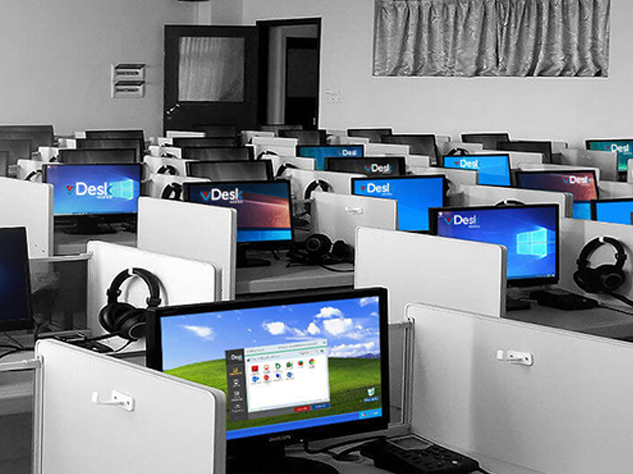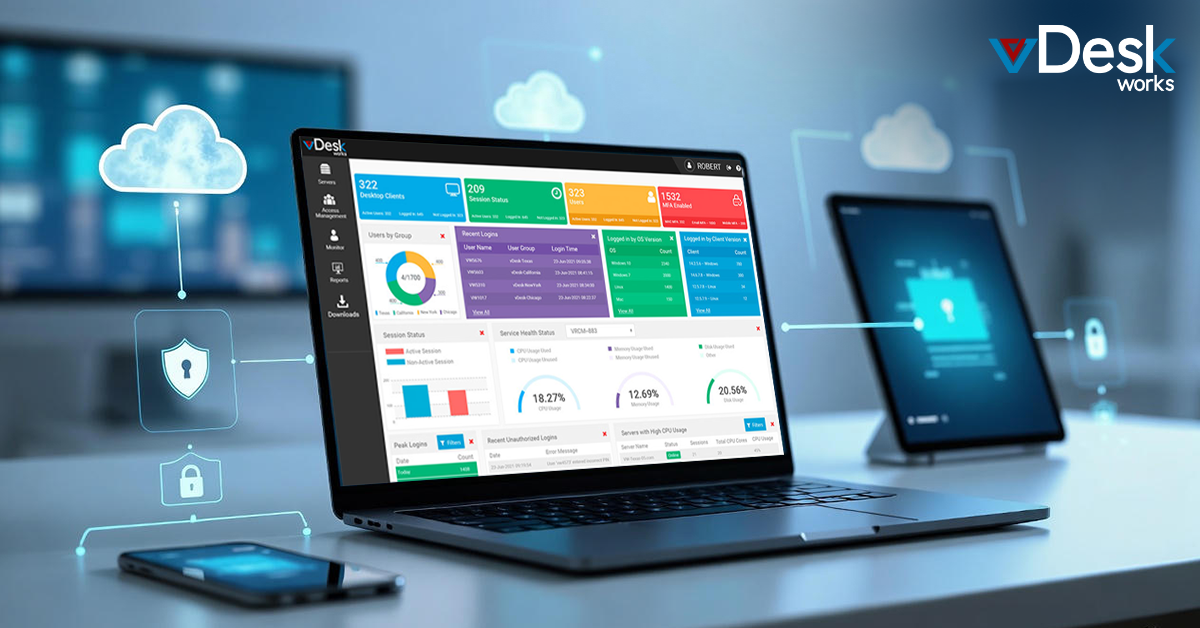For companies to do well in 2024 and the future, it is very important for them to offer a good remote desktop environment because this kind of work style keeps growing. This special working arrangement where people can work from anywhere has changed how businesses operate. The flexibility and freedom of remote work have made it attractive for many workers, leading to its rapid popularity.
As more companies adopt flexible work setups, optimize their digital resources, and hire distributed teams globally - the use of virtual desktop infrastructure (VDI) has become common practice. A remote desktop environment is an essential tool that helps employees access their virtual workspaces from various devices. It also allows them to connect with company applications as if they were using a traditional office computer.
However, offering a basic remote desktop service is no longer enough for businesses looking ahead to 2024 and beyond. The changing nature of work in this era requires us to improve how we provide our services; we need advanced solutions to ensure employees are productive while at home or elsewhere outside traditional office spaces. If your business wants its remote desktop environment to be seen as top-tier in 2024 and onwards, you should follow these seven rules:
1. Prioritize Performance and Reliability
The fundamental aspects of an efficient remote desktop environment are performance and reliability. As we move into 2024, remote workers expect their desktop environment to at least match or even surpass what they experience in a regular office setting. Thus, rule number one is to emphasize performance and reliability.
It's crucial to invest in strong infrastructure, fast internet connections, and effective remote desktop solutions to ensure that applications and data are available without interruption. By focusing on performance and dependability, we can offer workers from a distance a continuous desktop experience that reacts quickly even when they use it away from the office or on various devices.
2. Focus on Security and Compliance
Cyber threats are getting smarter, so safety is a big worry for remote desktop setups. Rule number two is about security and following the rules.
Encryption, multi-factor authentication, and endpoint protection are very important for securing delicate data and reducing security risks. Following industry regulations and standards is also crucial because it helps maintain trust and credibility with clients and stakeholders.
By paying attention to security and obedience, businesses can establish a safe and obedient remote desktop setting that safeguards against cyber dangers and fulfills regulatory needs. This will boost trust for both distant workers and those involved with the company's operations.
3. Embrace User-Centric Design
For a remote desktop environment to be successful, the user experience must be good. Rule number three: user-centric design.
Designs that are easy to understand, make work more efficient, and can be used by all types of people are important parts of user-centered design. Concentrating on the needs and likes of remote workers helps businesses improve the satisfaction and productivity of their users. Asking for feedback from remote workers and including their ideas in the design process is an important part of always improving the desktop experience.
If we apply a user-centric design, a remote desktop environment will become easier to use, intuitive, and suitable for those working from home. This could enhance productivity and involvement.
4. Enable Seamless Collaboration
For remote teams, it is crucial to work together effectively. Rule four is about enabling smooth collaboration.
It is very important to invest in collaboration tools like video calls, instant messages, and file sharing. These tools help with communication and collaboration among people working remotely. When we combine these tools with the remote desktop environment, we create a unified work experience, which helps teams in different places work together easily.
Smooth collaboration can promote teamwork, creativity, and new ideas in remote worker scenarios, increasing output and business triumphs.
5. Ensure Scalability and Flexibility
Rule five in an ever-changing business atmosphere is about scalability and flexibility.

It is very important to select a remote desktop solution that can grow according to your business's requirements and handle changing workloads. This may mean embracing flexible deployment methods, like those found in the cloud, so companies can adjust themselves over time and support a worldwide remote working environment.
For future protection, the remote desktop environment must be capable of scaling up and adapting. This ensures that as business requirements and market situations change, the environment can expand and adapt to handle increased demands.
6. Provide Comprehensive Support
For remote workers, it's important to have quick and dependable help when dealing with problems and ensure they can work as efficiently as possible. We call this rule number six: "Comprehensive Support".
It is very important to set up a specific support team or helpdesk to handle technical questions, solve problems, and guide remote workers. Self-service tools like resources, training materials, and knowledge bases help users find solutions for common issues on their own. This reduces the time they spend not working and increases productivity.
To help with technical issues and make sure remote workers can do their job well, giving full support is crucial for businesses. This boosts productivity and makes them happier in their role.
7. Foster a Culture of Remote Work
Establishing a good remote work culture is crucial for achieving a distant desktop environment. Rule number seven is to promote a culture of remote work.
Promoting teamwork, talking, and achieving equilibrium between the job and personal life can build a good culture for remote teams. Giving praise, enjoying successes together, and encouraging feelings of belonging and friendship among remote workers can create a positive work environment that supports everyone's needs.
When businesses create a culture that supports remote work, it can help improve employee engagement, keep them with the company for longer, and ensure their satisfaction. This will lead to higher productivity and overall success for the business.
To sum up, it is important to have a plan that focuses on performance, security, user experience, collaboration, and growth. Also, it should consider the support and culture of remote work when creating the top remote desktop environment in 2024. If businesses follow these seven rules, they can create an environment for their employees where they can work well together with high safety from any place on Earth where there's access to an internet connection and computer devices available.
To achieve these aims, you could consider using the Cloud Desktop Solution of vDesk.works. vDesk.works can help businesses improve their experience with remote desktops by giving them advanced characteristics, unmatched dependability, and user-friendly interfaces. vDesk.works focus on performance, safety, and user-friendliness, making it possible for businesses to offer an uninterrupted and efficient remote work setting for their workers.
Please call or email vDesk.works for further information on how to provide the best remote desktop environment in 2024 and after. With vDesk.works, you can enable your remote working team to perform at their maximum level and contribute towards business achievements during this digital era.


 Emma Carson
Emma Carson
















